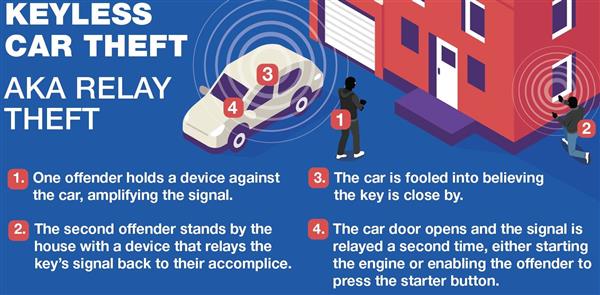|
I wanted to provide an update regarding the theft of motor vehicles, which members around this area have highlighted as an issue of concern on the Met Engage priority survey. What is Keyless Car Theft?
Keyless car theft (aka Relay Theft/Relay Crime) is where the signal from a key for a so-called “Keyless entry” car is captured by somebody standing outside the victim’s house using a device.
Keyless Car Theft – How It Works
Step 1 – The device transmits the signal to somebody else standing by the victim’s car.
Step 2– This then fools the car into thinking the key is near it, and so it allows the doors to be opened and ignition to be started.
How Long Does Keyless Car Theft Take to Happen?
Keyless car theft can take only 20-30 seconds.
What device is used in Keyless Car Theft?
Relay crime is when a certain type of specialist electronic equipment captures the signal from the Key and transmits it to a receiver that somebody standing next to the car has.
Is My Car Keyless Entry?
If you have to push a button on your car keys to enter your car, you are not at risk of being “hacked”.
Only cars with a keyless entry system can be stolen using so called “relay” equipment.
Keyless entry cars allow the driver to unlock and start the car with the key fob still in their pocket. Once in the car, the driver can press a button to start the engine.
1. Use a Signal blocking pouch (Faraday Bag) – Keep your car keys safe
Car key burglaries are on the increase, why not keep your car keys in a safe!
If you have a ‘keyless entry’ car, then make sure your keys are kept well away from doors and windows.
Keep your car key in a screened box/tin/bag so that the signal can’t be ‘grabbed’ from the outside and used to open your car – and don’t forget to do the same with any spare set!
Signal Blocking pouches are also known as Faraday Bags or Pouches
Why Use a Signal Blocking Pouch (Faraday Bag)
Signal Blocking pouches can stop access to your vehicle by blocking your car key fob from transmitting its code to the vehicle, as the pouches are lined with layers of metallic material.
2. Turn off Keyless Fob’s Wireless Signal
Do you have a keyless fob? Wireless signals on some keyless fobs can be switched off.
To turn off your wireless signal, you should look in your car’s manual to see if you can do this.
If you can’t find anything in your manual about turning off your fob, you should contact the vehicle’s manufacturer.
3. Use a Steering Wheel Lock or Car Alarm to stop Keyless Car Theft
Another method to prevent keyless car theft is by fitting a steering wheel lock or car alarm.
Most modern car thieves are equipped with laptops rather than hand tools, so mechanical devices – such as steering wheel locks – can be a real deterrent.
4. Park in a Garage at Night to Prevent Keyless Car Theft
Park your car in a garage overnight is ideal to stop keyless car theft, this increases the distance between your car and potential thieves trying intercept and amplify the signal from your car key fob.
Don’t have a garage or park on your driveaway? – If you’re parking on your driveway, park defensively, i.e. as close to your property as you can.
Extra Security to Prevent Keyless Car Theft. Consider upgrading our home security, by fitting outdoor motion detector lighting and CCTV cameras. If you park on the street, ensure it’s in an area that is well lit.
A local MLA master locksmith can undertake a home security check and advise on how to best to upgrade your outdoor security.
5. Get your windows etched (Vin Etching)
Etching the last seven digits of your Vehicle Identity Number (or registration) onto the windows, headlights and mirrors means anybody tries to steal your vehicle by keyless car theft will have a tough job when trying to alter your vehicle’s identity.
6. Keep your vehicle tidy can prevent Car Keyless Car Theft
We’ve all heard it, but how many still don’t follow the advice.
Make sure to keep the inside of your vehicle clear of clutter, try and hide any electrical items such as Sat Navs & Mobile phones.
Try to keep your glove box empty, and why not leave your glove box open to show you’ve got nothing to hide.
Don’t forget to hide any signs of high-cost equipment as well, such as the marks that Sat-Nav suction cups leave on your windscreen!
 We know that people can be concerned about the personal and financial impact of having their vehicle stolen, which is why we will pursue and arrest those who break the law. Please consider taking the following steps to keep your vehicle safe: Check that your vehicle is locked and secure every time you leave it. Thieves often look for easy opportunities to steal from vehicles. They will usually try the handles until they get lucky and find one that has been left unlocked. Keep your keys safe, out of view when at home and away from your front door. If you have a keyless entry vehicle, keep the key well away from the vehicle while at home and turn off wireless signals on your fob when its not being used. Consider putting the keys in a screened or signal blocking pouch, such as a Faraday Bag and check that it is still working every few months. Park your vehicle in a private garage if you can. If you don’t have access to one, try to park in a well –lit open space. Try to use public car parks that are part of the police approved Park Mark safer parking scheme. Secure your number plates with tamper resistant screws to avoid them being stolen and used by others.
If you ever experience this issue or have information regarding an incident, please report it using our online reporting tools at https://www.met.police.uk/, speak to an operator in our Force Communications Room via our online web chat or call the non-emergency number 101. Alternatively, you can stay 100% anonymous by contacting the independent charity Crimestoppers on 0800 555 111 or via their untraceable online form at crimestoppers-uk.org. We are working on our brand-new strategy for how we police London and we want your help. Our New Met for London: Phase 2 strategy will guide how we deliver on behalf of Londoners over the next three years, and we want to make sure you have had the chance to have your say. The consultation paper is available online, as well as a survey to let us know what you think. This closes on the 15 September. |















